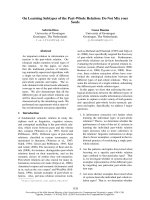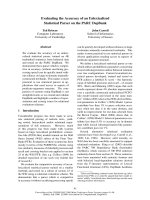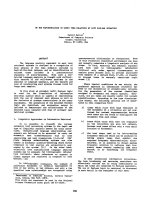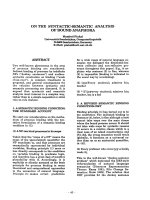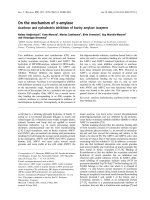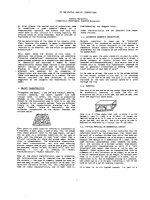Báo cáo khoa học: "ON THE EXISTENCE OF PRIMITIVE MEANING UNITS " potx
Bạn đang xem bản rút gọn của tài liệu. Xem và tải ngay bản đầy đủ của tài liệu tại đây (250.74 KB, 4 trang )
ON THE EXISTENCE OF PRIMITIVE MEANING UNITS
Sharon C. Salveter
Computer Science Department
SUNY Stony Brook
Stony Brook, N.Y. 11794
ABSTRACT
Knowledge representation schemes are either based on
a set of primitives or not. The decision of whether
or not to have a primitive-based scheme is crucial
since it affects the knowledge that is stored and how
that knowledge may be processed. We suggest that a
knowledge representation scheme may not initially have
primitives, but may evolve into a prlmltive-based
scheme by inferring a set of primitive meaning units
based on previous experience. We describe a program
that infers its own primitive set and discuss how the
inferred primitives may affect the organization of
existing information and the subsequent incorporation
of new information.
i. DECIDING HOW TO REPRESENT KNOWLEDGE
A crucial decision in the design of a knowledge repre-
sentation is whether to base it on primitives. A prim-
itive-based scheme postulates a pre-defined set of mean-
ing structures, combination rules and procedures. The
primitives may combine according to the rules into more
complex representational structures, the procedures
interpret what those structures mean. A primltive-free
scheme, on the other hand, does not build complex struc-
tures from standard building blocks; instead, informa-
tion is gathered from any available source, such as
input and information in previously built meaning
structures.
A hybrid approach postulates a small set of pro-defined
meaning units that may be used if applicable and con-
venient, but is not limited to those units. Such a
representation scheme is not truly prlmitive-based
since the word "primitive" implies a complete set of
pre-deflned meaning units that are the onl 7 ones avail-
able for construction. However, we will call this hy-
brid approach a primitive-based scheme, since it does
postulate some pro-defined meaning units that are used
in the same manner as primitives.
2. WHAT
IS
A PRIMITIVE?
All representation systems must have primitives of some
sort, and we can see different types of primitives at
different levels. Some primitives are purely structural
and have little inherent associated semantics. That is,
the primitives are at such a low level that there are
no semantics pre-deflned for the primitives other than
how they may combine. We call these primitives struc-
tural primitives. On the other hand, semantic primi-
tives have both structural and semantic components.
The structures are defined on a higher level and come
with pre-attached procedures (their semantics) that
indicate what they "mean," that is, how they are to be
meaningfully processed. What makes primitives semantic
is this association of procedures with structures, since
the procedures operating on the structures give them
meaning. In a primitive-based scheme, we design both
a set of structures and their semantics to describe a
specific environment.
There are two problems with pre-defining primitives.
First, the choice of primitives may be structurally
inadequate. That is, they may limit what can be repre-
sented. For example, if we have a set of rectilinear
primitives, it is difficult to represent objects in a
sphere world. The second problem may arise even if we
have a structurally adequate set of primitives. I_n this
case the primitives may be defined on too low a level
to be useful. For example, we may define atoms as our
primitives and specify how atoms interact as their
semantics. Now we may adequately describe a rubber ball
structurally, hut we will have great difficulty describ-
ing the action of a rolling ball. We would like a set
of semantic primitives at a level both structurally and
semantically appropriate to the world we are describing.
3. INFERRING AN APPROPRIATE PRIMITIVE SET
Schank [1972] has proposed a powerful primitive-based
knowledge representation
scheme
called conceptual
dependency. Several natural language understanding
programs have been written that use conceptual depend-
ency as their underlying method of knowledge represen-
tation. These programs are among the most successful
at natural language understanding. Although Schank
does not claim that his primitives constitute the only
possible set, he does claim that some set of primitives
is necessary in a general knowledge representation
scheme.
Our claim is that any advanced, sophisticated or rich
memory is likely to be decomposable into primitives,
since they seem to be a reasonable and efficient method
for storing knowledge. However, this set of after-the-
fact primitives need not be pre-defined or innate to
a representation scheme; the primitives may be learned
and therefore vary depending on early experiences.
We really have two problems: inferring from early
experiences a set of structural primitives at an appro-
priate descriptive level and learning the semantics to
associate with these structural primitives. In this
paper we shall only address the first problem. Even
though we will not address the semantics attachment
task, we will describe a method that yields the minimal
structural units with which we will want to associate
semantics. We feel that since the inferred structural
primitives will be appropriate for describing a par-
titular environment, they will have appropriate seman-
tics and that unlike pro-defined primitives, these
learned primitives are guaranteed to be at the appro-
priate level for a given descriptive task. Identify-
ing the structural primitives is the first step (prob-
ably a parallel step) in identifylng semantic primi-
tives, which are composed of structural units and
associated procedures that 81ve the structures meaning.
This thesis developed while investigating learning
strategies. Moran [Salveter 1979] is a program that
learns frame-like structures that represent verb mean-
ings. We chose a simple representative frame-like
knowledge representation for Moran to learn. We chose
a primitive-free scheme in order not to determine the
level of detail at which the world must be described.
As Moran learned, its knowledge base, the verb world,
evolved from nothing to a rich interconnection of frame
structures that represent various senses of different
root verbs. When the verb world was "rich enough" (a
heuristic decision), Moran detected substructures,
which we call building blocks, that were frequently
used in the representations of many verb senses across
root verb boundaries. These building blocks can be
used as after-the-fact primitives. The knowledge
representation scheme thus evolves from a primitive-
free state to a hybrid state. Importantly, the build-
ing blocks are at the level of description appropriate
13
Co how the world was described to Moran. Now Mor~ may
reorganize the interconnected frames that make up the
verb world with respect co the building blocks. This
reorganizaclon renulcs in a uniform identification of the
co alleles and differences
of
the various
meanings
of different
root:
verbs. As
l enrning
continues the new
knowledge incorporated into the verb world will also be
scored, as ,-~ch as possible, with
respect
to
the build-
ins blocks; when processing subsequent input, Moran
first tries to use a on~inatlon of the building blocks
to represent the
meaning
of each new situation iC
encoiJ~Cer8
•
A sac of building blocks, once inferred, need noc be
fixed forever; the search for more building blocks may
continue as the knowledge base becomes richer. A
different, "better," set of
building blocks may be
in-
ferred later from the richer knowledge and all knowledge
reorganized with respect
to
them. If we can assume
that
initial inputs are representaClve of future inputs,
subsequent processing will approach that of primitive-
based systems.
4. AN OVERVIEW OF MORAN
Moran is able to "view" a world that is a room; the
room
Contains
people and objects, Moran has pre-defined
knowledge of the contents of the room. For exan~le, it
knows chac lamps, cables and chairs are all types of
furniture, Figaro is a
male,
Ristin is a female, Eistin
and Figaro are human. As
input to
a learning crlal,
Moran
is
presented
with:
i) a snapshot of the room Just before an action
oct%tEn
2) a snapshot of tbe room Just after the action is
completed end
3) a parsed sentence thac describes the action thac
occured in the two-snapshot sequence.
The
learning
task
is to associate a frame-like structure,
called a Conceptual Meaning Structure (CMS), with each
root verb it enco,mcers. A CMS is a directed acyclic
graph that represents the types of entities chat partic-
ipate in an action and the changes the entities undergo
during the action.
The ~s are organized so thac the similarities among
various senses of a given root verb are expllcicly rep-
resented b 7 sharing nodes in a graph. A CMS is organ-
ized
into two
par~s: an ar~,-~-cs graph
and an
effects
graph. The arguments graph stores cases and case slot
restrictions, the effects graph stores a description of
what happens co the entities described in the arg,,m~,~Cs
graph when an action "takes place."
A sin~llfled example of a possible ~S for the verb
"throw" is shown in Figure i. Sense i, composed of argu-
ment
and effect nodes labelled A, W and X
can
represent
'~kr 7 throws the ball." Ic show thac during sense 1 of
the
actlan "throw," a human agent remains
at
a location
while a physical object changes location from where the
Agent is to another location. The Agent changes from
being in a stare of physical contact with the Object co
not being in physical contact with ic. Sense 2 is com-
posed of nodes labelled A, B, W and Y; It might repre-
sent "Figaro throws the ball co E-Istin." Sense 3, com-
posed
of nodes labelled A, B, C, W, X and Z, could rep-
resent "Sharon threw the terminal at Raphael."
Mor~- infers a CMS for each root verb it encotmters.
Although similarlt~'es among different senses of the
same root verb are recognized, similarities are noC
recognized across C~S boundaries; true synonyms might
have id~-tlcal graphs, but Moran would have no knowledge
arguments
~ 1,2,3
.TECT PhysobJ
A: Location
|C2 Location
2,3
B: ! PREP Prespositi~
I~O~
~,,m. |
c: Ic3
Location
J
W:
X: [ AGENT PHYSCONT OBJECT > null I
effects
1,2,3
I AGENT AT Cl > AGENT AT C1 I
OBJECT AT Cl ~> OBJECT AT C2
Ii,3 ,~ 2
I I~DOBJ AT C2 > INDO~
AT
C2
Y: AGENT PHYSCONT OBJECT
>
INDOBJ PHYSCONT OBJECT
Figure 1.
14
of the similarity. Similarities among verbs that are
close in meaning, but not synonyms, are not represented;
the fact that "move" and "throw" are related is not ob-
vious to Moran.
5. PRELIMINARY RESULTS
A primitive meaning unit, or building block, should be
useful for describing a large number of different mean-
ings. Moran attempts to identify those structures that
have been useful descriptors. At a certain point in the
learning process, currently arbitrarily chosen by the
h.m;un trainer, Moran looks for building blocks that have
been used to describe a number of different root verbs.
This search for building blocks crosses CMS boundaries
and occurs only when memory is rich enough for some
global decisions to be made.
Moran was presented with twenty senses of four root
verbs: move, throw, carry and buy. Moran chose the
following effects as building blocks:
i) Agent (h,,~ ) AT Casel (location)
Agent (human) AT Casel (location)
* a human agent remains at a location *
2) Agent (human) AT Casel (location)
$
Agent (human) AT Case2 (location)
* a human agent changes location *
3) Object (physicalobj) AT Casel (location)
1,
Object
(physicalobj) AT Case2 (location)
* a physical object changes location *
4) Agent (human) PHYSICALCONTACT Object (physlcalobJ)
Agent
(human)
PHYSICALCONTACT Object (physicalobJ)
* a human agent remains in physical con=at=
with a physical object *
Since Moran has only been presented with a small number
of verbs of movement, it is not surprising that the
building blocks it chooses describe Agents and Objects
moving about the environmen= and their interaction with
each other. A possible criticism is that the chosen
building blocks are artifacts of the particular descrlp-
tions that were given to Moran. We feel this is an
advantage rather than a drawback, since Moran must as-
sume that the world is described to it on a level that
will be appropriate for subsequent processing.
In Schank's conceptual dependency scheme, verbs of move-
ment are often described with PTRANS and PROPEL. ~t is
interesting that some of the building blocks Moran in-
ferred seem to be subparts of the structures of PTRANS
and PROPEL. For example, the conceptual dependency for
"X throw Z at Y" is:
)
Y
|
D
X~ ) PROPEL +.S- Z (
J
!
(X
where X and Y are b,,m"ns and Z is a physical object.
see the object, Z, changing from the location of X to
that of Y. Thus, the conceptual dependency subpart:
We
)
<o
z <D
J
appears to
be
approximated by building block ~3 where
the Object changes location. Moran would recoEnize
that the location change is from the location of the
Agent to the location of the indirect object by the
interaction of building block #3 with other buildlng
blocks and effects that participate in the action
description.
Similarly, the conceptual dependency for "X move Z to
W" is :
z<~)ioc(w)
where X and Z have the same restrictions as above and
W is a location. Again we see an object changing loca-
tion; a co,~-on occuzence in movement and a building
block Moran identified.
6. CONCLUDING REMARKS
We are currently modifying Moran so that the identified
building blocks are used to process subsequent input.
That is, as new situations are encountered, Moran will
try to describe them as much as possible in terms of
the building blocks. It will be interesting to see
how these descriptions differ from the ones Moran would
have constructed if the building blocks had not been
available. We shall also investigate how the existence
of the building blocks affects processing time.
As a cognitive model, inferred primitives may account
for the effects of "bad teaching," that is, an unfor-
tunate sequence of examples of a new concept. If ex-
amples are so disparate that few building blocks exist,
or so unrepresentative that the derived building blocks
are useless for future inputs, then the after-the-fact
primitives will impede efficient representation. The
knowledge organization will not tie together what we
have experienced in the past or predict that we will
experience in the future. Although the learning pro-
gram could infer more useful building blocks at a later
timeg that process is expensive, time-consuming and may
be unable to replace information lost because of poor
building blocks chosen earlier. In general, however,
we must assume that our world is described at a level
appropriate to how we must process it. If that is the
case, then inferring a set of primitives is an advanta-
geous strateEy.
REFERENCES
[Salveter 1979] Inferring conceptual graphs. Co~nltive
Science, 1979, 3_, 141-166.
[Schank 1972] Conceptual Dependency: a theory of
natural language understanding. Cobnitive
Psychology, 1972, ~, 552-631.
15

